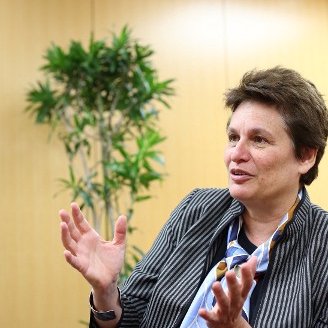
Florian Engert
@EngertLab
Followers
3K
Following
43
Media
24
Statuses
392
Harvard University
Joined July 2015
How much do we *really* learn? In @NatRevNeurosci with @EngertLab and @AFerreiraCastro, we address why most of you humans firmly believe that patterned activity plays a necessary and instructive role in shaping neural circuits. https://t.co/YLkZzfPjb6
nature.com
Nature Reviews Neuroscience - In this Perspective, Barabási, Ferreira Castro and Engert challenge the notion that learning and plasticity primarily drive the assembly of neural circuits. They...
2
16
106
This mechanistic reductionist approach allows us now to make explicit predictions about the underlying neural circuits in the visuomotor processing stream, and thereby guide future whole-brain imaging and neural recording experiments to get at the underlying neural circuits.
0
0
0
This modeling framework accurately captures our behavior findings, and allows us to make novel behavioral predictions that we confirm in subsequent experiments.
1
0
0
Based on these experimental findings we generate a time-varying state space model that links the history of visual stimulation to the strength of inter-individual interactions, thereby providing a quantitative, predictive, framework for the modulation of collective behavior.
1
0
0
Remarkably, it is not translational motion, as reflected by other fish passing by, but it is - very specifically - looming stimuli, as induced by neighbors approaching, that is critical for changing the internal state of the animals.
1
0
0
We precisely measure the time dynamics of these modulations and find that they develop slowly over tens of minutes and remain stable for many hours. Notably, we have isolated the specific visual features of neighbors swimming in the vicinity that induce the modulation.
1
0
0
We find that already at a very young age (7 days post fertilization), previously experienced social densities strongly modify the current collective behavior of the larvae: experience with high social densities decreases the vigor of inter-individual responses and vice versa.
1
0
0
In the new project we used, in a very similar fashion, naturalistic and virtual reality experiments and computational analysis to study how the history of experienced social environments modifies these individual-level computations and changes the resulting collective behaviors.
1
0
0
It is an extension of a previous story where we have described the precise visuomotor transformations that underlie collective behaviors in these small and amazing animals (Harpaz et al,. 2021 Nat Comm).
1
0
1
The story is entitled Experience-dependent modulation of collective behavior in larval zebrafish https://t.co/dK0zg22WRL
biorxiv.org
Complex group behavior can emerge from simple inter-individual interactions. Commonly, these interactions are considered static and hardwired and little is known about how experience and learning...
1
1
10
Check out the latest project that came out of the phenomenally productive collaboration that Roy Harpaz (@RoyHarpaz) has initiated a few years ago by bridging the joint expertises of @engertlab and the team of Mark Fishman (also here at Harvard).
2
10
33
Nature Over Nurture: Functional Neuronal Circuits Emerge in the Absence of Developmental Activity [Engert Lab] @EngertLab @GregorFPS @bdanubius
https://t.co/HgstowYlaP
2
7
49
Now out in @NatureComms, our paper on activity- and experience- independent maturation of sensorimotor behaviors in zebrafish. @GregorFPS @EngertLab Since the preprint, we added new experiments confirming the effect and washout of anesthesia 👇 https://t.co/5OQRptjQiZ
Nature over Nurture: with @GregorFPS and @EngertLab, we find that functional neuronal circuits emerge in the absence of developmental activity. Essentially, complex visuo-motor pathways mature even without activity-dependent refinement 🧵 https://t.co/UXERDqTciu
3
15
55
This has become one of my favorite papers. We're very VERY far away from understanding how the brain works. https://t.co/URRf2eLgAi
thelancet.com
A 44-year-old man presented with a 2-week history of mild left leg weakness. At the age of 6 months, he had undergone a ventriculoatrial shunt, because of postnatal hydrocephalus of unknown cause....
14
38
305
@DulacLab @harvardbrainsci @MCB_Harvard @EngertLab @BOlveczky Great article! Bon voyage @BOlveczky and @EngertLab (love the t-shirt). Impressive challenge.
0
2
4
I got very interesting colleagues @harvardbrainsci and @MCB_Harvard 🤣🤣 Good luck @EngertLab and @BOlveczky in your crazy sailing adventure!... https://t.co/IeCUtPlojl
thetransmitter.org
The two neuroscientists leave this week to take on the most dangerous leg of the Clipper Round the World Yacht Race — sailing from South Africa to Australia through the fabled “Roaring Forties,”…
4
9
61
The true star and hero of the story is Kumaresh Krishnan who defended his PhD recently with this project and a few others of similar impact and excitement 😁😁
0
0
5
while ‘competence’ is influenced mainly by the environment in which fish are raised. A link to a preprint copy is here https://t.co/EuVgUzCQ6V
researchgate.net
PDF | Decision making strategies in the face of conflicting or uncertain sensory input have been successfully described by a drift diffusion to bound... | Find, read and cite all the research you...
1
1
6
Another really remarkable finding that emerged when we used our assay to dissect the consequences of specific environmental and genetic perturbations, is that the extent of ‘focus’ is largely inherited from the parents,
1
0
5
This is cool, because it resonates with an explanation for a failure to perform also in humans: we can either be not focused, or just not very good at a task if our performance is lacking.
1
0
2










